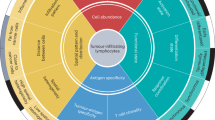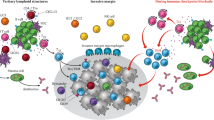Abstract
SEVERAL studies have demonstrated that cell-mediated immunity to animal and human tumours can be measured in vitro by colony inhibition or microcytotoxicity tests in which immune lymphoid cells kill and/or inhibit the growth of tumour cells1,2, and more recent studies have attempted to extend these results by measuring the relative contributions of T and B lymphocytes to the anti-tumour effects noted3,4. The principle upon which these latter experiments have been based is that selective depletion of one or the other lymphocyte subpopulation, followed by measurement of the capacity of the residual population to produce an effect, should indicate which sub-population is operative in the system. But, conclusions drawn from such experiments are critically dependent upon the assumption that the remaining lymphocyte subpopulation is not contaminated with other cell types; or, if it is, the contaminating cells are unlikely to be effector cells in the assay used because they are inactive and/or infrequent. Acceptance of this assumption requires careful evaluation; for as we have observed in the present investigation of effector cells operating during the primary immune response to murine Moloney sarcomas, a cell type of low frequency may contribute in a major way to the cytotoxic effects noted in vitro. Furthermore, these cells are present in considerable numbers within regressing tumours in vivo.
This is a preview of subscription content, access via your institution
Access options
Subscribe to this journal
Receive 51 print issues and online access
$199.00 per year
only $3.90 per issue
Buy this article
- Purchase on SpringerLink
- Instant access to full article PDF
Prices may be subject to local taxes which are calculated during checkout
Similar content being viewed by others
References
Takasugi, M., and Klein, E., Transplantation, 9, 219–227 (1970).
Hellstrom, I., Hellstrom, K. E., Sjogren, H. O., and Warner, G. A., Int. J. Cancer, 7, 1–16 (1971).
Lamon, E. W., Wigzell, H., Klein, E., Andersson, B., and Skurzak, H. M., J. exp. Med., 137, 1472–1493 (1973).
Plata, F., Gomard, E., Leclerc, J. C., and Levy, J. P., J. Immun., 112, 1477–1487 (1974).
Seeger, R. C., and Owen, J. J. T., Transplantation, 15, 404–408 (1973).
Seeger, R. C., Rayner, S. A., and Owen, J. J. T., Int. J. Caner, 13, 697–713 (1974).
Owen, J. J. T., and Seeger, R. C., Br. J. Cancer, 28, 26–34.
Currie, G. A., and Gage, J. O., Br. J. Cancer, 28, 136–146.
Keller, R., J. exp. Med., 138, 625–644 (1973).
Allison, A. C., Harlington, J. S., Birbeck, M., J. exp. Med, 124, 141–154 (1966).
Leclerc, J. C., Gomard, E., Plata, F., and Levy, J. P., Int. J. Cancer, 11, 426–432 (1973).
Herberman, R. B., Nunn, M. E., Lauvin, D. H., and Asofsky, R., J. natn. Cancer Inst., 51, 1509–1513 (1973).
Author information
Authors and Affiliations
Rights and permissions
About this article
Cite this article
SEEGER, R., OWEN, J. Anti-tumour cytotoxic effects mediated by minor and major cell populations of lymph nodes. Nature 252, 420–421 (1974). https://doi.org/10.1038/252420a0
Received:
Issue date:
DOI: https://doi.org/10.1038/252420a0



